Chapter 15 Equilibria of Other Reaction Classes
Chapter 15 Equilibria of Other Reaction Classes

The mineral fluorite, CaF2 (Figure 15.1), is commonly used as a semiprecious stone in jewelry because of its striking appearance. Deposits of fluorite are formed through a process called hydrothermal precipitation in which calcium and fluoride ions dissolved in groundwater combine to produce insoluble CaF2 in response to some change in solution conditions. For example, a decrease in temperature may trigger fluorite precipitation if its solubility is exceeded at the lower temperature. Because fluoride ion is a weak base, its solubility is also affected by solution pH, and so geologic or other processes that change groundwater pH will also affect the precipitation of fluorite. This chapter extends the equilibrium discussion of other chapters by addressing some additional reaction classes (including precipitation) and systems involving coupled equilibrium reactions.
